Finite Element Analysis on a Newly-Modified Method for the Taylor Impact Test to Measure the Stress-Strain Curve by the Only Single Test Using Pure Aluminum
Abstract
:1. Introduction
2. Experimental Principle
2.1. A Proposition of a Modified Taylor Impact Test
2.2. The Hardening Law to Nonlinear Strain Rate Sensitivity for the Finite Element Simulation
2.3. A Removing Method of the Frictional Effect in Impact Compressive Tests Based on the SHPB Technique
3. Experimental Methods
3.1. Material and Specimen
3.2. Quasi-Static and Impact Compressive Tests at Different Strain Rates and Temperatures
4. Finite Element Simulation of the Modified Taylor Impact Test
5. Results and Discussions
5.1. Compressive Test from Quasi-Static to Impact Range
5.2. Computation of the Modified Taylor Impact Test by FEM
6. Concluding Remarks
- It is possible to obtain a valid stress-strain curve at only one single trial of the Taylor impact test.
- In the Phase 2, the distribution of the axial internal force can be approximated bi-linearly with respect to the axial position of the specimen.
- It can be observed that the axial stress decreases mainly in the region of higher strain.
- The choice of elapsed time during Phase 2 is quite important, in order to obtain the correct stress-strain curve.
Author Contributions
Funding
Acknowledgments
Conflicts of Interest
References
- Taylor, G. The use of flat-ended projectiles for determining dynamic yield stress. Proc. R. Soc. Lond. Ser. A 1948, 194, 289–299. [Google Scholar] [CrossRef]
- Piao, M.; Huh, H.; Lee, I.; Ahn, K.; Kim, H.; Park, L. Characterization of flow stress at ultra-high strain rates by proper extrapolation with Taylor impact tests. Int. J. Impact Eng. 2016, 91, 142–157. [Google Scholar] [CrossRef]
- Sarva, S.; Mulliken, A.D.; Boyce, M.C. Mechanics of Taylor impact testing of polycarbonate. Int. J. Solids Struct. 2007, 44, 2381–2400. [Google Scholar] [CrossRef]
- Millett, J.C.F.; Bourne, N.K.; Stevens, G.S. Taylor impact of polyether ether ketone. Int. J. Impact Eng. 2006, 32, 1086–1094. [Google Scholar] [CrossRef]
- Lopanikov, S.L.; Gama, B.A.; Haque, M.J.; Krauthauser, C.; Gillesspie, J.W.; Guden, M., Jr.; Hall, I.W. Dynamics of metal foam deformation during Taylor cylinder-Hopkinson bar impact experiment. Compos. Struct. 2003, 61, 61–71. [Google Scholar] [CrossRef]
- Yahaya, M.A.; Ruan, D.; Lu, G.; Dargusch, M.S.; Yu, T.X. Selection of densification strain to predict dynamic crushing stress at high impact velocity of ALPORAS aluminium foam. Key Eng. Mater. 2015, 626, 383–388. [Google Scholar] [CrossRef]
- Wilkins, M.L.; Guinan, M.W. Impact of cylinders on a rigid boundary. J. Appl. Phys. 1973, 44, 1200–1206. [Google Scholar] [CrossRef]
- Mocko, W.; Janiszewski, J.; Radziejewska, J.; Grazka, M. Analysis of deformation history and damage initiation for 6082-T6 aluminium alloy loaded at classic and symmetric Taylor impact test conditions. Int. J. Impact Eng. 2015, 75, 203–213. [Google Scholar] [CrossRef]
- Forde, L.C.; Proud, W.G.; Walley, S.M. Symmetrical Taylor impact studies of copper. Proc. R. Soc. A 2009, 465, 769–790. [Google Scholar] [CrossRef] [Green Version]
- Jones, S.E.; Maudlin, P.J.; Foster, J.C., Jr. An engineering analysis of plastic wave propagation in the Taylor test. Int. J. Impact Eng. 1997, 19, 95–106. [Google Scholar] [CrossRef]
- Jones, S.E.; Drinkard, J.A.; Rule, W.K.; Wilson, L.L. An elementary theory for the Taylor impact test. Int. J. Impact Eng. 1998, 21, 1–13. [Google Scholar] [CrossRef]
- Julien, R.; Jankowiak, T.; Rusinek, A.; Wood, P. Taylor’s test technique for dynamic characterization of materials: Application to brass. Exp. Tech. 2016, 40, 347–355. [Google Scholar] [CrossRef]
- Safa, K.; Gary, G. Displacement correction for punching at a dynamically loaded bar end. Int. J. Impact Eng. 2010, 37, 371–384. [Google Scholar] [CrossRef] [Green Version]
- Allen, D.J.; Rule, W.K.; Jones, S.E. Optimizing material strength constants numerically extracted from Taylor impact data. Exp. Mech. 1997, 37, 333–338. [Google Scholar] [CrossRef]
- Sakino, K. Strain rate sensitivity of dynamic flow stress of FCC metals at very high strain rates. Transact. Jpn. Soc. Mech. Eng. Ser. A 1997, 63, 939–944. [Google Scholar] [CrossRef]
- Iwamoto, T.; Yokoyama, T. Effects of radial inertia and end friction in specimen geometry in split Hopkinson pressure bar tests: A computational study. Mech. Mater. 2012, 51, 97–109. [Google Scholar] [CrossRef]
- Kii, N.; Iwamoto, T.; Rusinek, A.; Jankowiak, T. A study on reduction of friction in impact compressive test based on the split Hopkinson pressure bar method by using a hollow specimen. Appl. Mech. Mater. 2014, 566, 548–553. [Google Scholar] [CrossRef]
- Johnson, G.R.; Cook, W.H. A constitutive model and data for metals subjected to large strains, high strain rates, and high temperatures. Proc. 7th Int. Sympo. Ballist. 1983, 541–547. Available online: https://ci.nii.ac.jp/naid/20000193157/ (accessed on 13 August 2018).
- House, J.W.; Aref, B.; Foster, J.C., Jr.; Gillis, P.P. Film data reduction from Taylor impact tests. J. Strain Anal. Eng. Des. 1999, 34, 337–345. [Google Scholar] [CrossRef]
- Ramberg, W.; Osgood, W.R. Description of Stress-Strain Curves by Three Parameters; Technical Note No. 902; National Advisory Committee for Aeronautics: Washington, DC, USA, 1943.
- Zerilli, F.J.; Armstrong, R.W. Dislocation-mechanics-based constitutive relations for material dynamics calculations. J. Appl. Phys. 1987, 61, 1816–1825. [Google Scholar] [CrossRef] [Green Version]
- Jia, D.; Ramesh, K.T. A rigorous assessment of the benefits of miniaturization in the Kolsky bar system. Exp. Mech. 2004, 44, 445–454. [Google Scholar] [CrossRef]
- Iwamoto, T.; Cherkaoui, M.; Sawa, T. A study on impact deformation and transformation behavior of TRIP steel by finite element simulation and experiment. Int. J. Mod. Phys. B 2008, 22, 5985–5990. [Google Scholar] [CrossRef]
- Iwamoto, T.; Kawagishi, Y.; Tsuta, T.; Morita, S. Identification of constitutive equation for TRIP steel and its application to improve mechanical properties. JSME Int. J. Ser. A 2001, 44, 443–452. [Google Scholar] [CrossRef]
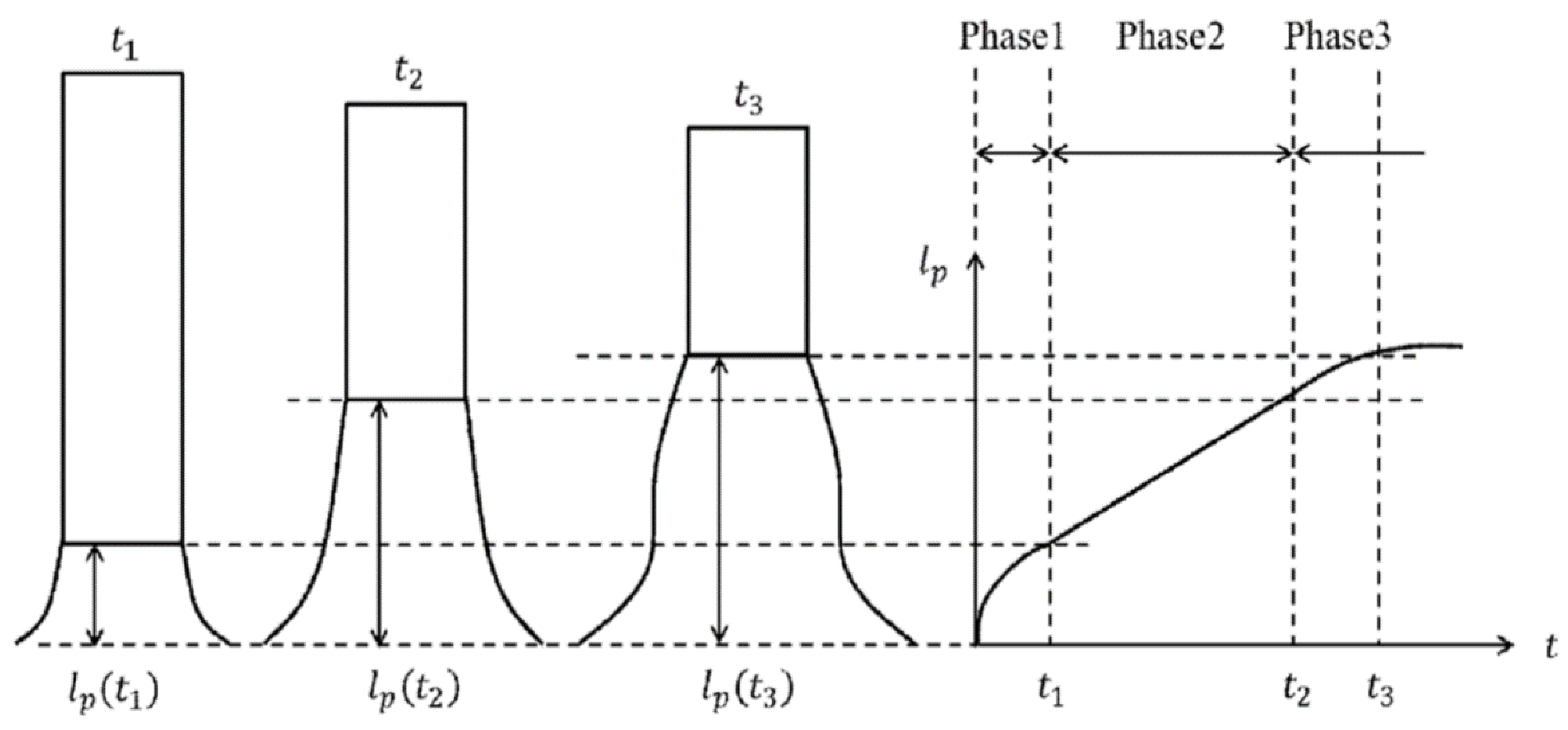
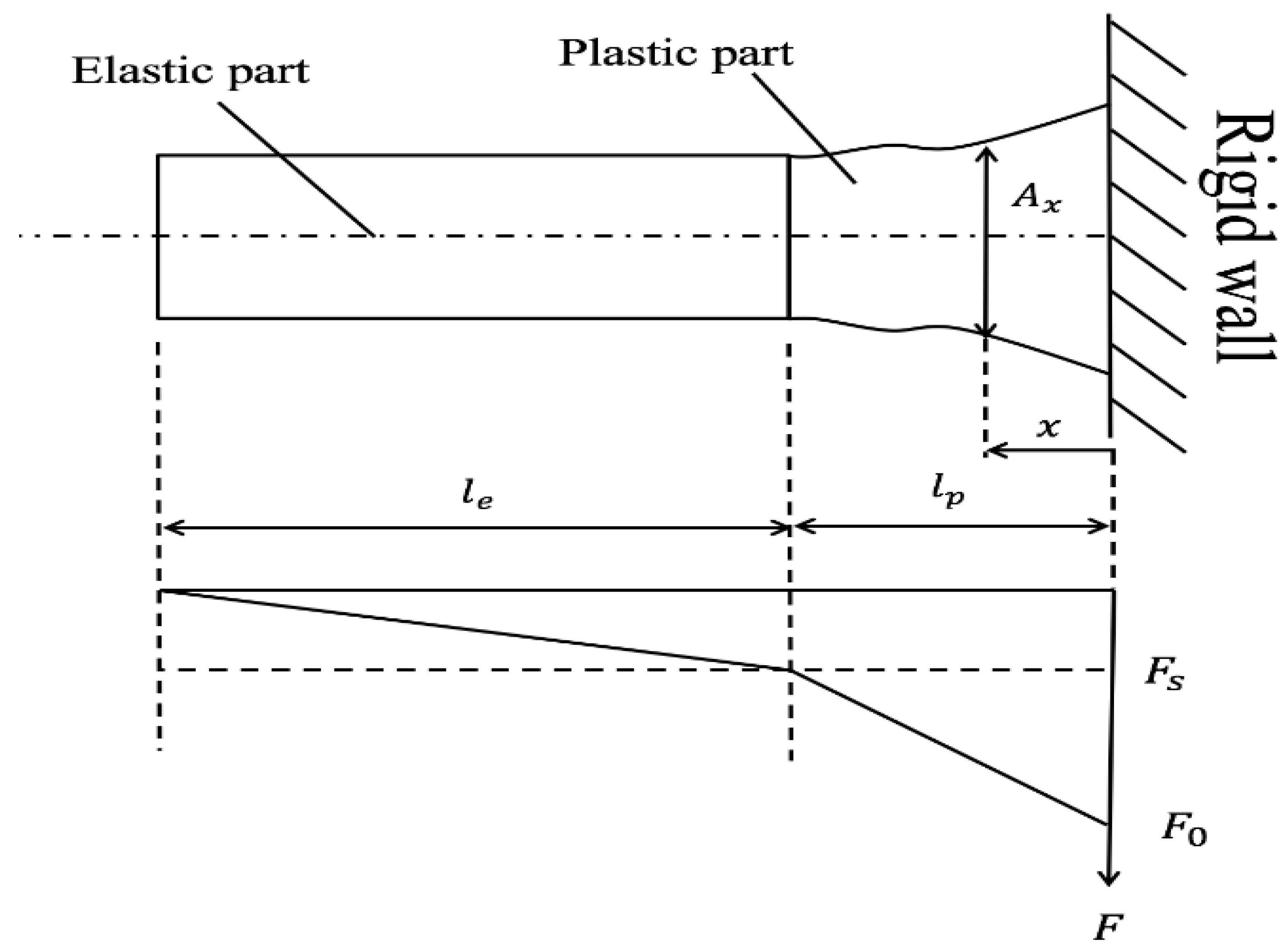



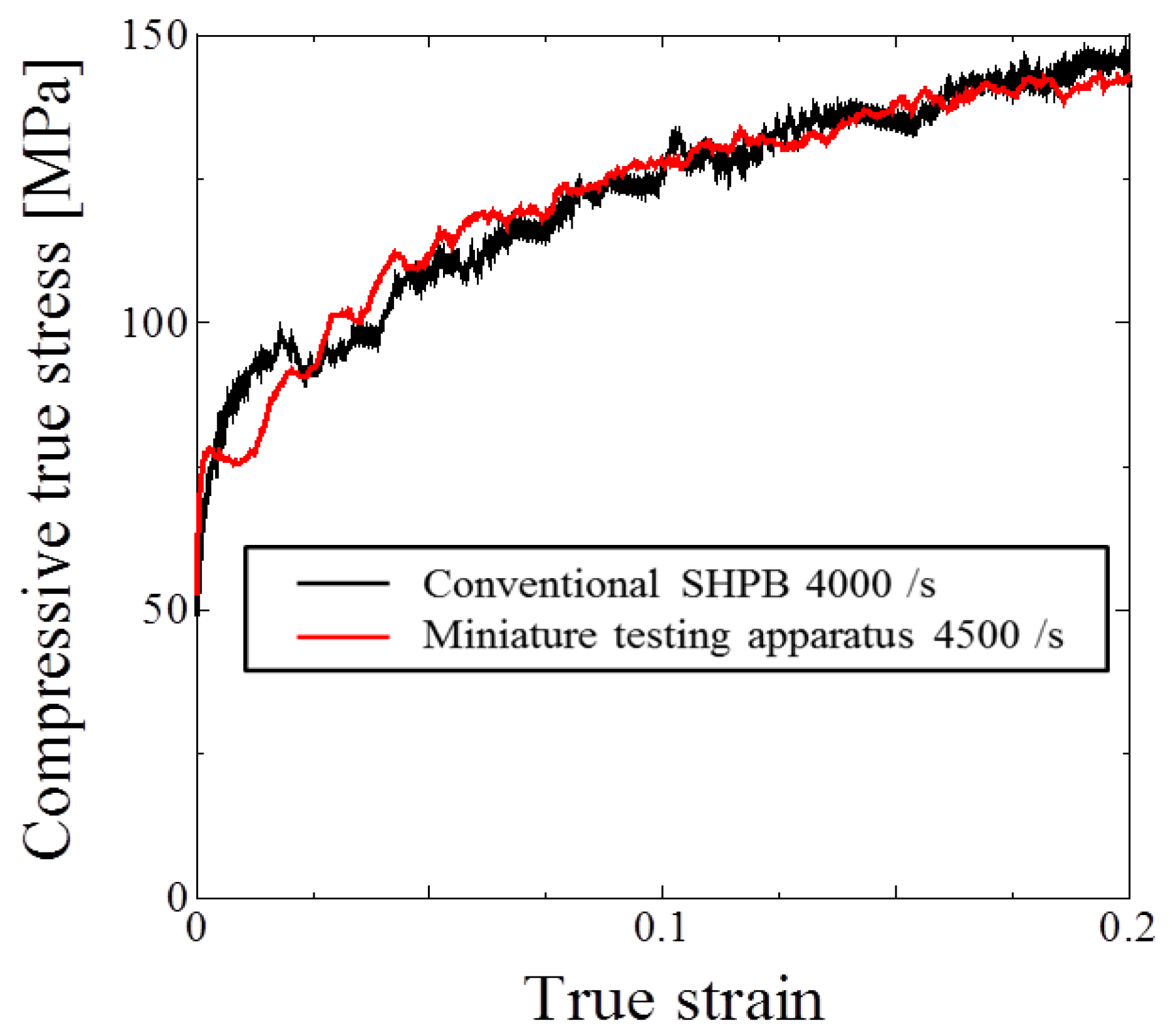
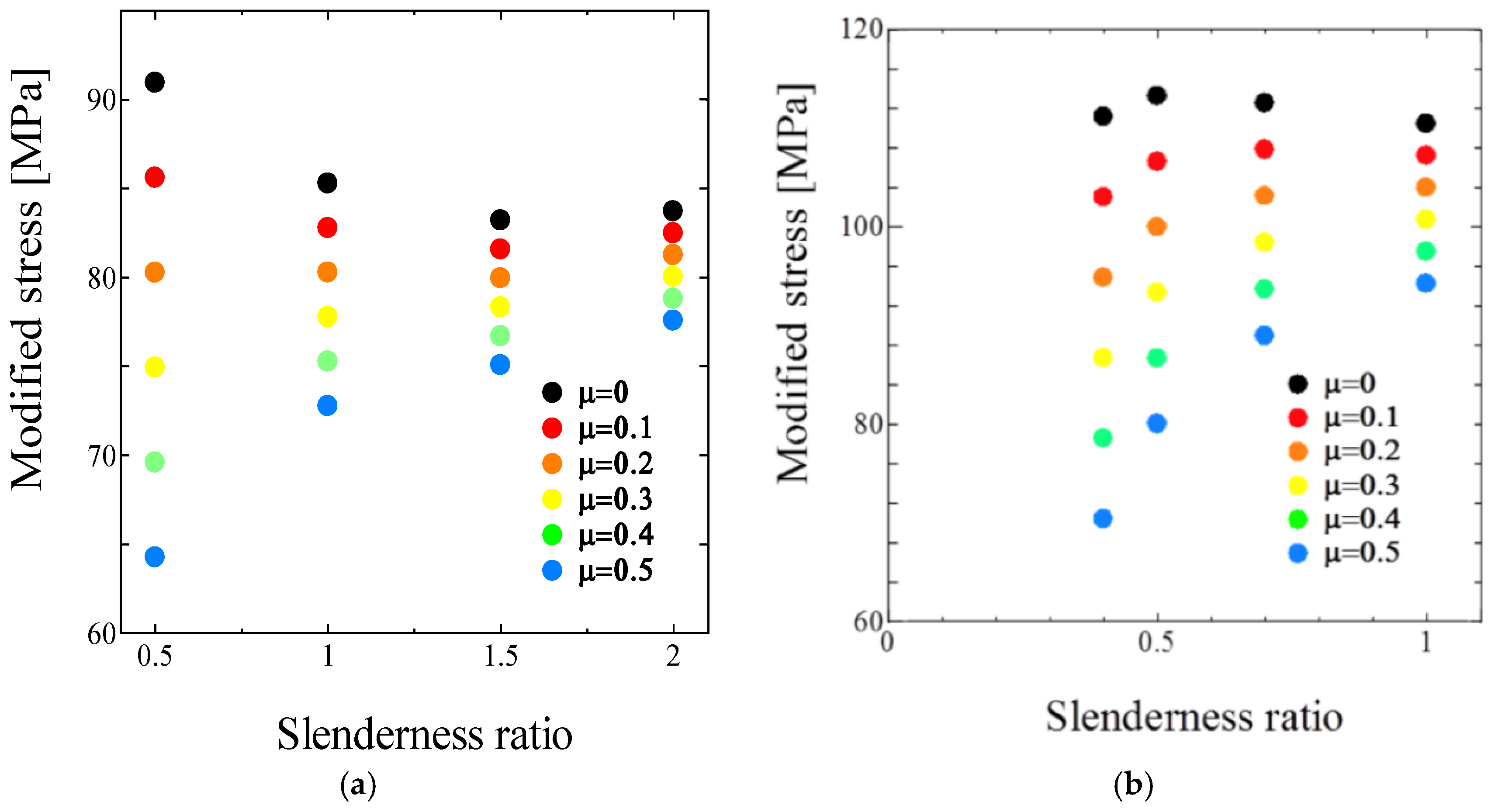
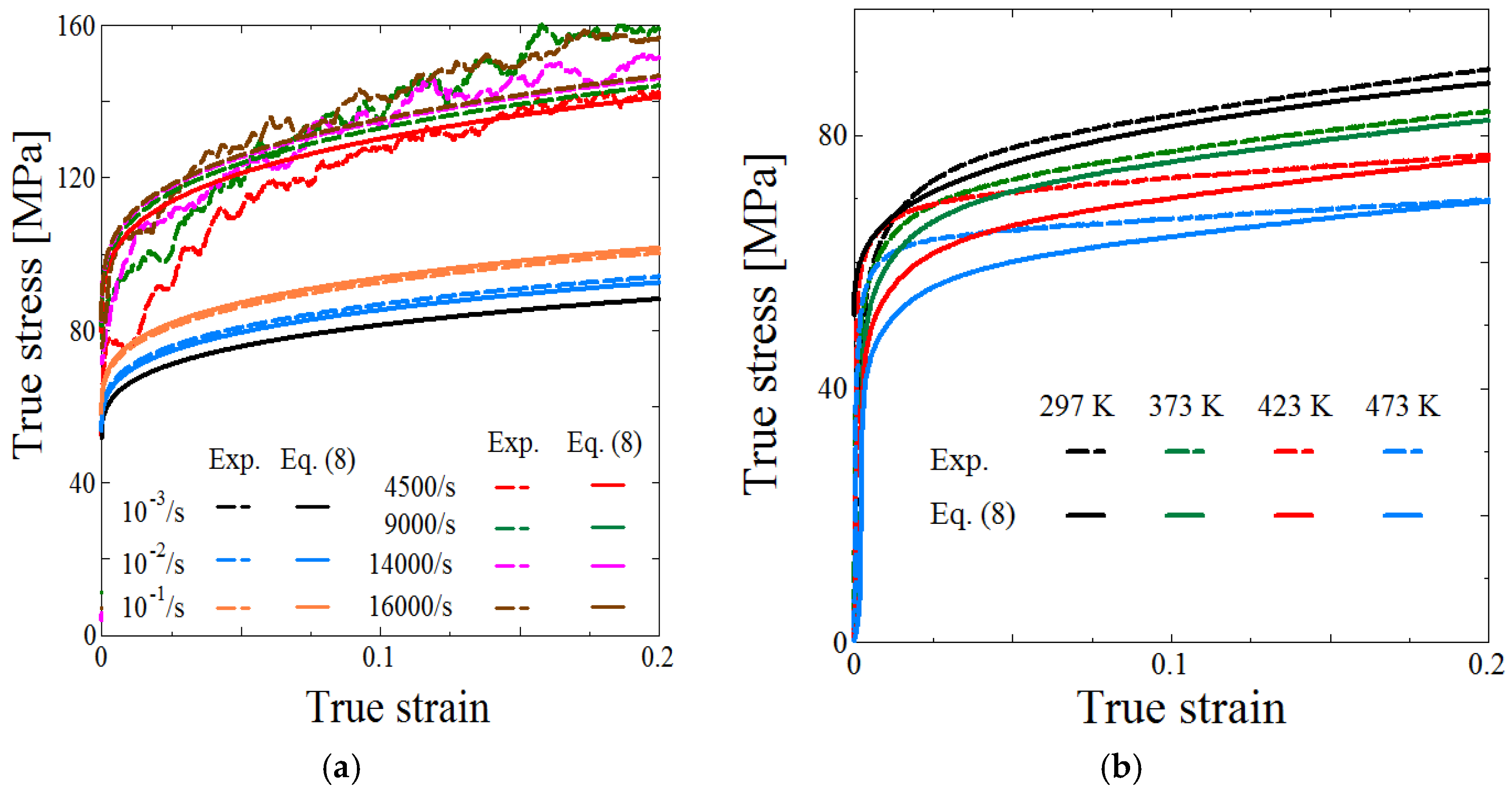
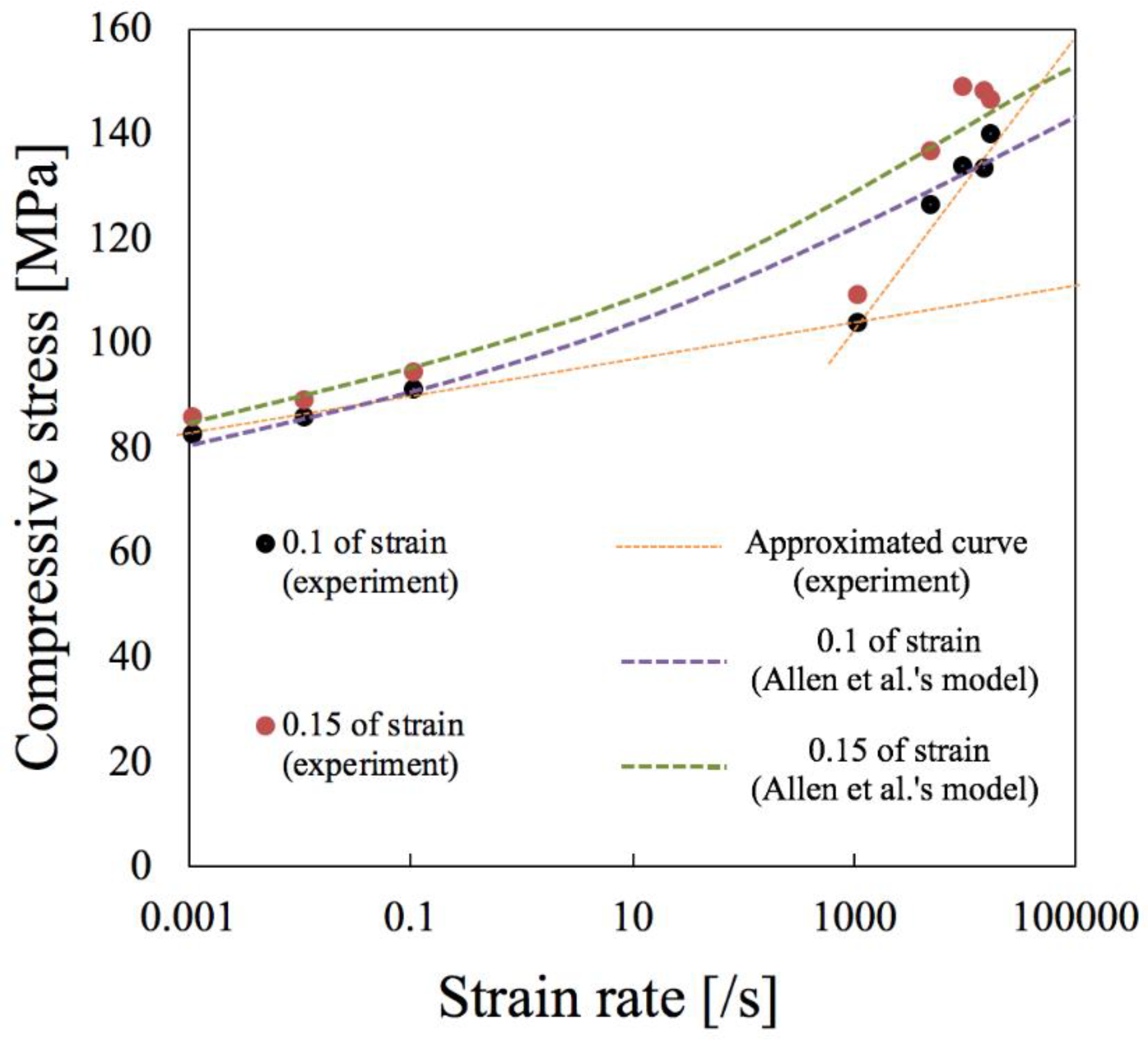

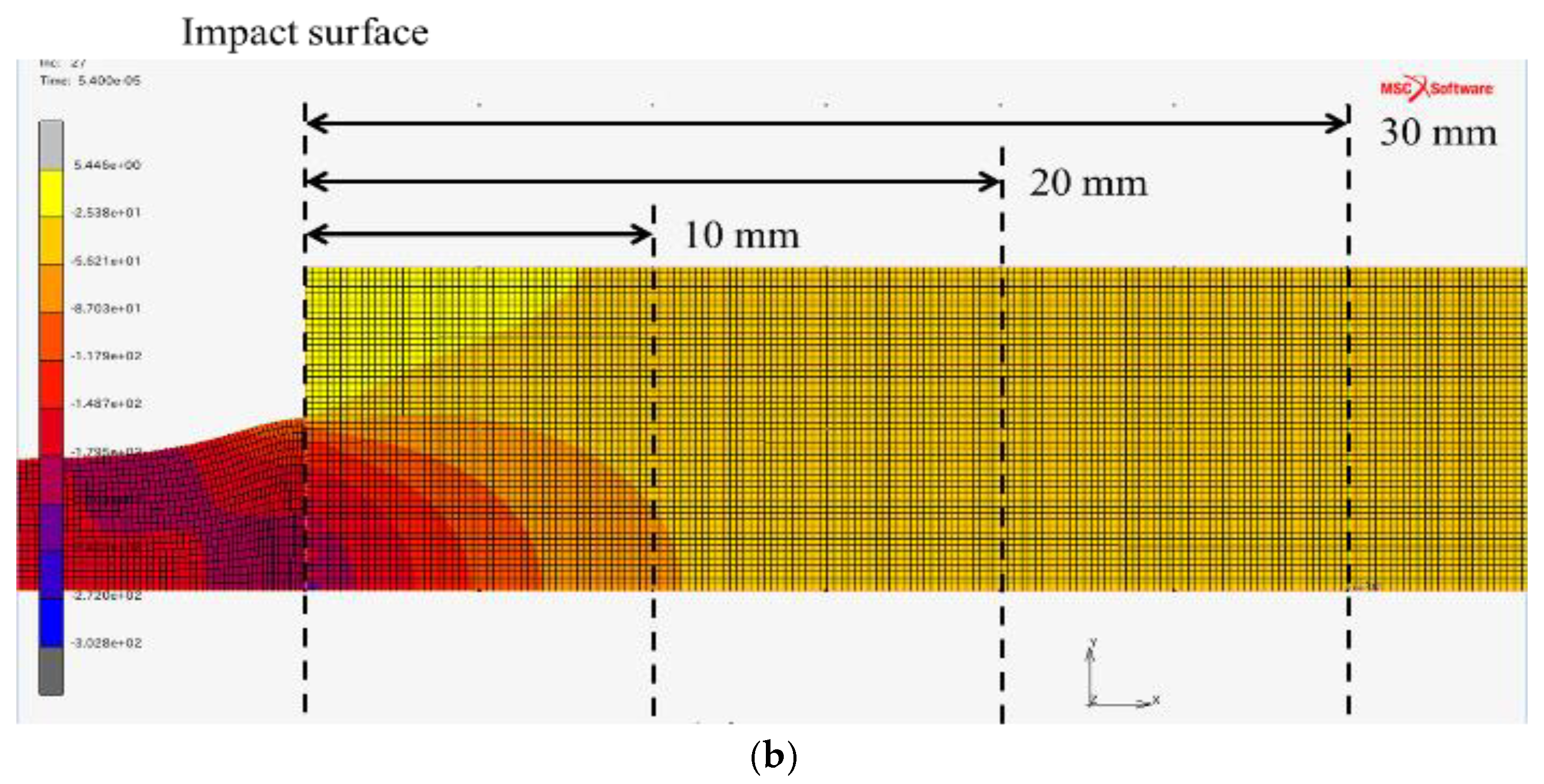
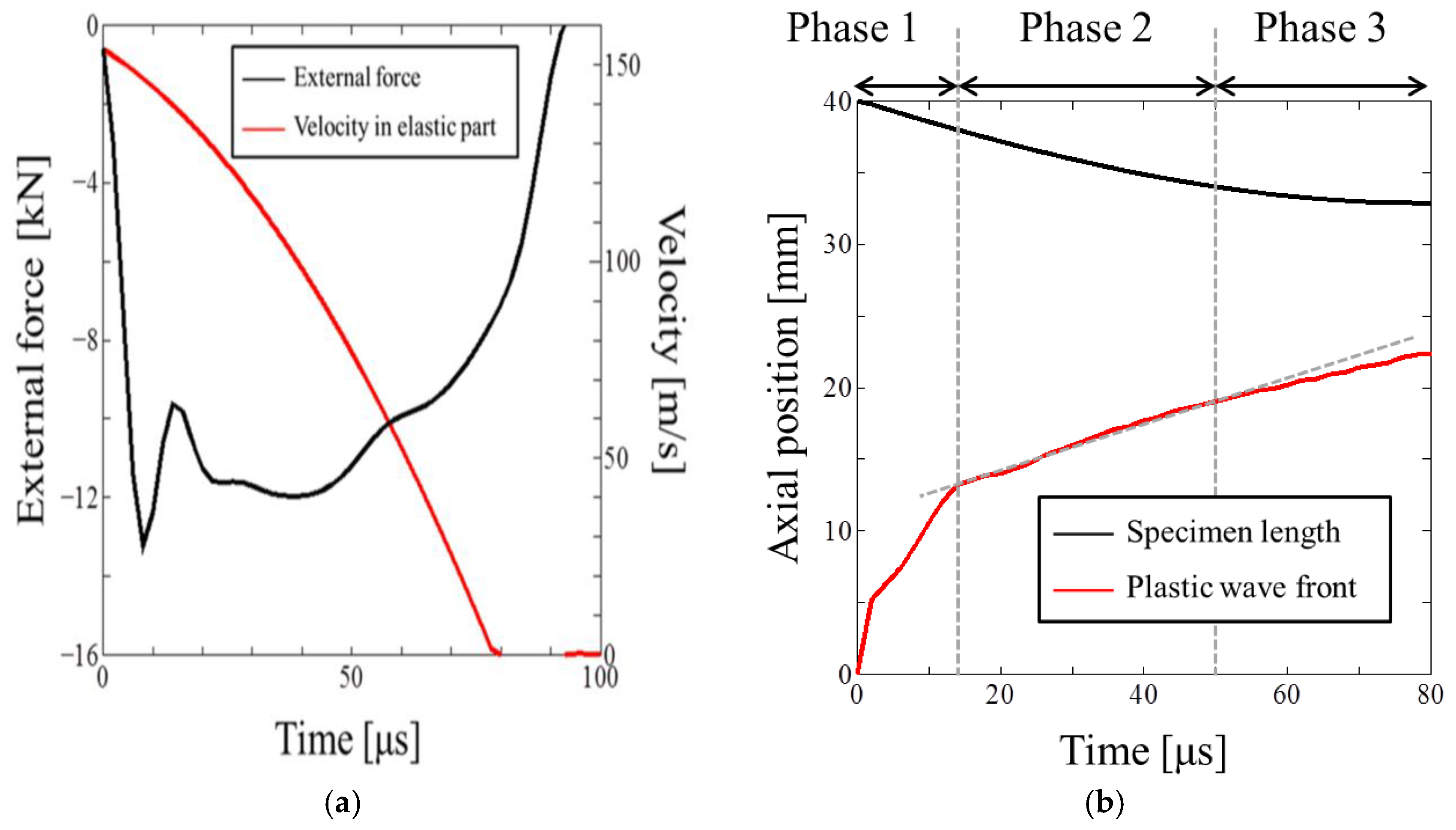
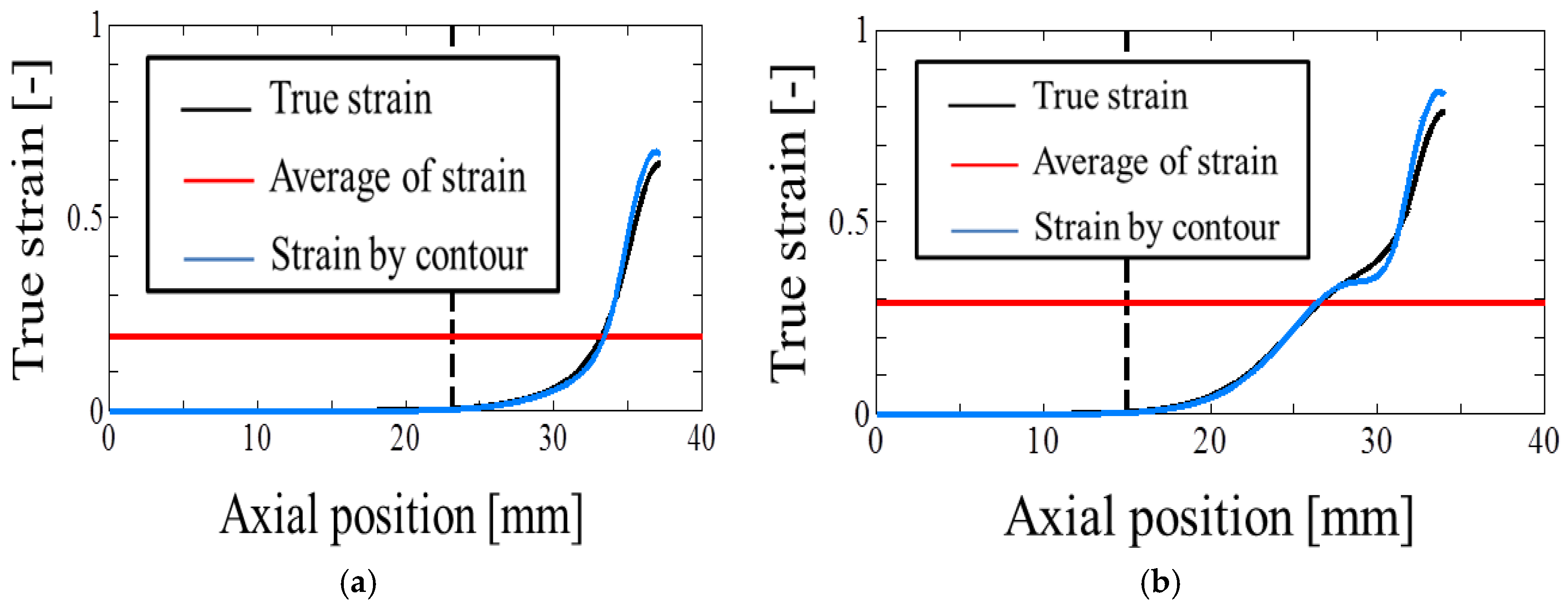

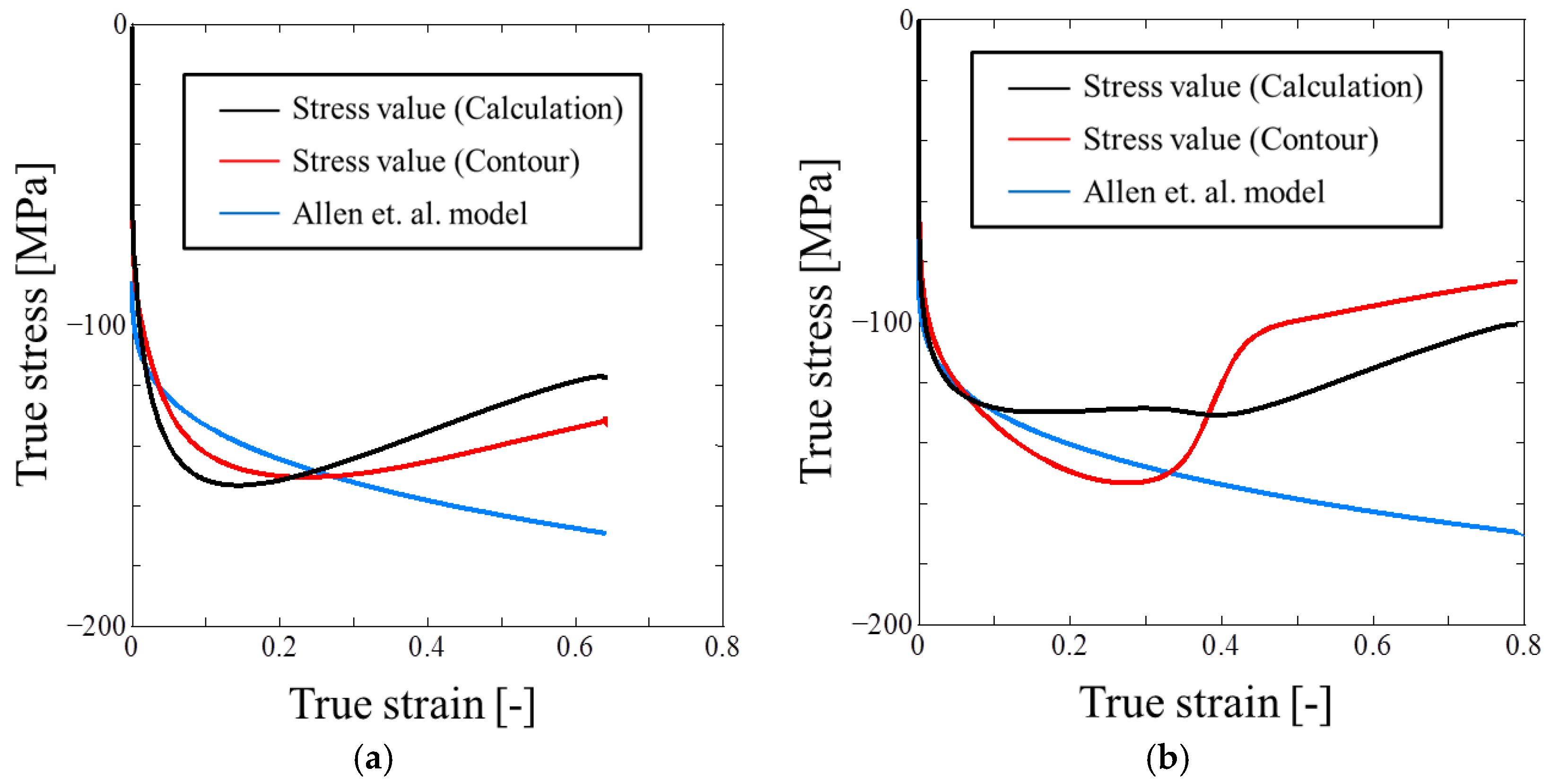
| 49.7 | 60.6 | 0.282 | 0.001 | 0.0307 | 1.14 |
© 2018 by the authors. Licensee MDPI, Basel, Switzerland. This article is an open access article distributed under the terms and conditions of the Creative Commons Attribution (CC BY) license (http://creativecommons.org/licenses/by/4.0/).
Share and Cite
Gao, C.; Iwamoto, T. Finite Element Analysis on a Newly-Modified Method for the Taylor Impact Test to Measure the Stress-Strain Curve by the Only Single Test Using Pure Aluminum. Metals 2018, 8, 642. https://doi.org/10.3390/met8080642
Gao C, Iwamoto T. Finite Element Analysis on a Newly-Modified Method for the Taylor Impact Test to Measure the Stress-Strain Curve by the Only Single Test Using Pure Aluminum. Metals. 2018; 8(8):642. https://doi.org/10.3390/met8080642
Chicago/Turabian StyleGao, Chong, and Takeshi Iwamoto. 2018. "Finite Element Analysis on a Newly-Modified Method for the Taylor Impact Test to Measure the Stress-Strain Curve by the Only Single Test Using Pure Aluminum" Metals 8, no. 8: 642. https://doi.org/10.3390/met8080642





